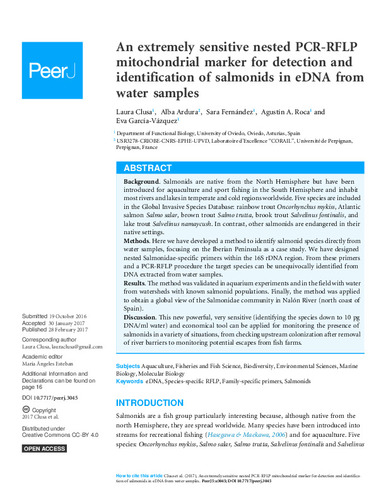An extremely sensitive nested PCR-RFLP mitochondrial marker for detection and identification of salmonids in eDNA from water samples
Subject:
eDNA
Species-specific RFLP
Family-specific primers
Salmonids
Publication date:
Editorial:
PeerJ
Publisher version:
Citación:
Descripción física:
Abstract:
Background. Salmonids are native from the North Hemisphere but have been introduced for aquaculture and sport fishing in the South Hemisphere and inhabit most rivers and lakes in temperate and cold regions worldwide. Five species are included in the Global Invasive Species Database: rainbow trout Oncorhynchus mykiss, Atlantic salmon Salmo salar, brown trout Salmo trutta, brook trout Salvelinus fontinalis, and lake trout Salvelinus namaycush. In contrast, other salmonids are endangered in their native settings. Methods. Here we have developed a method to identify salmonid species directly from water samples, focusing on the Iberian Peninsula as a case study. We have designed nested Salmonidae-specific primers within the 16S rDNA region. From these primers and a PCR-RFLP procedure the target species can be unequivocally identified from DNA extracted from water samples. Results. The method was validated in aquarium experiments and in the field with water from watersheds with known salmonid populations. Finally, the method was applied to obtain a global view of the Salmonidae community in Nalón River (north coast of Spain). Discussion. This new powerful, very sensitive (identifying the species down to 10 pg DNA/ml water) and economical tool can be applied for monitoring the presence of salmonids in a variety of situations, from checking upstream colonization after removal of river barriers to monitoring potential escapes from fish farms.
Background. Salmonids are native from the North Hemisphere but have been introduced for aquaculture and sport fishing in the South Hemisphere and inhabit most rivers and lakes in temperate and cold regions worldwide. Five species are included in the Global Invasive Species Database: rainbow trout Oncorhynchus mykiss, Atlantic salmon Salmo salar, brown trout Salmo trutta, brook trout Salvelinus fontinalis, and lake trout Salvelinus namaycush. In contrast, other salmonids are endangered in their native settings. Methods. Here we have developed a method to identify salmonid species directly from water samples, focusing on the Iberian Peninsula as a case study. We have designed nested Salmonidae-specific primers within the 16S rDNA region. From these primers and a PCR-RFLP procedure the target species can be unequivocally identified from DNA extracted from water samples. Results. The method was validated in aquarium experiments and in the field with water from watersheds with known salmonid populations. Finally, the method was applied to obtain a global view of the Salmonidae community in Nalón River (north coast of Spain). Discussion. This new powerful, very sensitive (identifying the species down to 10 pg DNA/ml water) and economical tool can be applied for monitoring the presence of salmonids in a variety of situations, from checking upstream colonization after removal of river barriers to monitoring potential escapes from fish farms.
ISSN:
DOI:
Patrocinado por:
This work was supported by the Spanish project MINECO-13-CGL2013-42415-R and the Asturias Regional Grant GRUPIN-2014-093. Laura Clusa holds a PCTI Grant from the Asturias Regional Government, referenced BP14-145. Alba Ardura is recipient of a Postdoctoral Fellowship with reference Clarin-CO-FUND-PCTI-FICYT. Sara Fernández has received funding from the European Union's Horizon 2020 Research and Innovation program under Grant Agreement No 689682 (project AMBER). The EU RIA 689682- AMBER-partially contributed to this work.
Collections
- Artículos [37532]
- Biología Funcional [801]
- Investigaciones y Documentos OpenAIRE [8365]
Files in this item





